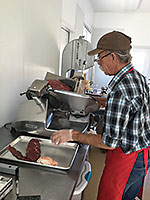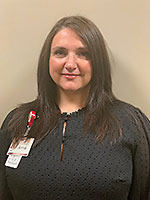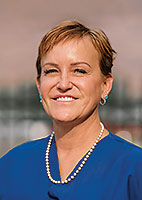|
|
HEALTHY HAPPENING February 2019
|
Nunn Better: Greg Nunn’s Eclectic Journey to Small-Scale Food Production
Written by Steph Hamborsky |
In early November, I arranged a time to visit and interview Greg Nunn, a long time member of the Moab valley community and an avid flint knapper, jerky purveyor, and cultivator of impressive carrots and peppers. On November 6th, I pulled into Greg’s driveway in Castle Valley and found him hard at work in his jerky processing kitchen. Listening to reggae and wearing a bright red apron, Greg noted his pasilla pepper seed stock drying on the windowsill and continued to slowly slice beef sourced from a ranch outside Cortez, Colorado while delving into his family’s history.
Greg’s nuclear family arrived in Moab from Santa Paula, California in 1971 when he was fifteen years old. Southern California’s Ventura County boasts the title of the “citrus capital of the world,” and his grandfather successfully cultivated citrus in the region. Greg’s family developed a cattle ranch and practiced dryland farming on Wilson Mesa. While Greg continued to work sporadically on his family’s ranch, he eventually purchased property and built a home in Moab and began to carve out his own life.
He sold his Moab property in the 1980s and decided to purchase his current ten acre property in Castle Valley. In the 1980s, Greg paid a mere $1,100 per acre. Moab had only begun to gain popularity as a tourist destination and internationally renowned hub for mountain biking. The uranium mining industry subsequently tanked, leaving the Moab economy in disarray. Greg lived in a trailer and began building a house a few years later. He aspired to farm the entire property and establish a homestead. Due to a crippling drought and complicated family dynamics, Greg’s family sold their property on Wilson Mesa in the 1990s.
As Greg explored the possibility of growing food on his land in Castle Valley, he submitted soil samples and learned that the mineral and nutrient content of the sandy soil would be particularly suited for the cultivation of root vegetables. Instead of embracing a typical market garden farming model, Greg firmly believes that small-scale growers should focus their energy on a few crops and perfect their growing techniques over time. He settled on primarily cultivating carrots and peppers due to their complimentary growing seasons. Greg plants his carrots in July, and the harvest begins in October and generally continues through April. During their long growing season in the summer and early fall, Greg harvests pasilla and other pepper varieties. For several years, he sold bell peppers and carrots to Rainbow Natural Foods, a small food distribution company which emerged from the alternative food movement of the 1960s and 1970s.
“That’s where people go wrong. They try to grow too much. Too many different things. [Pick] just a few items. And... you can [try to] make those few items make a continuous income.” - Greg Nunn
After experiencing a pepper fiasco one year, Greg explored other income generating options that did not depend as heavily on Moab’s fluctuating economy. He developed a passion for flint knapping, and his rigorous dedication to self-study blossomed into an expertise on the subject. He eventually sold to private stone tool collectors and participated in numerous excavations. Greg continues to work alongside Ph.D researchers and archeologists despite only attaining a high school education. Unfortunately, the actual processing of shaping flint can cause pneumonia and eventually silicosis, a disease of the lungs caused by the inhalation of silica dust. Greg noticed early signs of silicosis in himself and decided to mostly retire from the practice aside from occasional private projects. The building he currently uses for jerky processing was intended to be a lithic research center for people to travel from all over the world and study stone tools, but he decided to focus on cultivating and processing food items instead.
Eventually, Greg began selling his Nunn Better carrots to Moonflower Co-op. Derek Whitworth, Moonflower’s current General Manager, learned about Greg’s carrots from Conrad Sorensen, the founder of Lifestream, Moonflower’s predecessor. Prior to Conrad’s departure from the Co-op in 1999, Greg began selling his carrots to both Rainbow Natural Foods and the Co-op. When Derek returned from his brief hiatus from Moonflower in 2015, he asked Greg to grow carrots for the Co-op. Derek offered a fair price and a predictable market for Greg’s carrots, and they have remained a local produce staple ever since.
Greg aspires to increase production every year to keep up with local demand for his carrots. He hopes that he will have carrots through June. He wants to experiment with seeding carrots in the early spring to continue carrot production into the summer, but spring planting presents some unique challenges, namely cut worms and flea beetles. He initiated a nematode program this fall and plans to treat his beds again in the spring to attack their larva.
Greg also dabbles in several other projects on his Castle Valley property. He grows about 80 pounds of garlic per year and creates his own garlic powder, and much of this is incorporated into his signature jerky products. He boasts a small orchard featuring peaches, pears, plums, apples, and apricots and has experimented with cherries, nectarines, and almonds over the years. He once produced 50 gallons of wine per year from his grape vineyard, and recently he began making grape juice instead. He enjoys growing dahlias to sell as cut flowers to Forget Me Not, Moab’s local flower shop, and he cultivates a wide variety of native plants around his home.
“As long as my ground will hold up and my body will hold up, I’ll continue.” - Greg Nunn
Between producing Nunn Better carrots and jerky, Greg doesn’t have a day off. Crafting his products occupies most of his daylight hours, and he admits to struggling to find reliable, full time help in Castle Valley. However, Greg remains dedicated to providing Moab with nutritious and flavorful produce and value-added products throughout the year. Greg embodies the passion, tenacity, and resourcefulness required to farm successfully in a globalized, industrial food economy. Tangibly supporting and developing relationships with our local producers are essential components of strengthening our local economy and building community resilience. Residents of Moab and surrounding areas can find Greg’s Nunn Better carrots, pasilla powder, and jerky at Moonflower Co-op.
|
Gratitude & Growth
by Star Kolb
|
What has occurred over the past seven years of your life? Let’s take a moment to reflect…are you surprised by all that has changed and all that has grown? Now take a moment to be grateful for someone or something in your life…
So much happens in seven years: babies born, friends pass on, careers change, neighbors change, priorities shift, businesses open, some thrive-some close, relationships/friendships develop and our community holds strong. A community that has supported Moab Yoga for a full seven years!
March 1, 2012, a day Angela Houghton recalls big fluffy snowflakes falling while she swept the floor, watered the plants, opened the curtains and taught Moab Yoga’s first class. This is the inspiration that led Angela to open the yoga studio. It is to have a place filled with light and a space where all of the teachers in town can teach and share their offerings. Now, seven years later, Angela experiences that the studio seems to have an energy of its own.
As with many small businesses, there have been many changes in life and in Moab that have had Angela question whether the studio should or could continue. As with the practice of yoga’s discipline, reflection, and patience, Moab Yoga has developed into a community within a community. Angela loves the inspiration and growth that the practice of yoga provides for people to feel their best.
Now that Moab Yoga has a solid foundation, Angela envisions broadening the offerings at the studio and that more people will deepen a personal practice, especially meditation. This broadening is supported by our wonderful teachers and their continual study, travel, and practicing of yoga themselves. The studio and the teachers listen to the needs of the students and community, as we are all students first.
What Moab Yoga strives for is that all students, new and seasoned alike, try several classes and find the ones that speak to them, that meet their needs. All of the teachers have unique personalities and approaches to the practice of yoga. One element of yoga that has held true for thousands of years is that it’s a practice of self-reflection and growth. Angela recognizes that yoga isn’t about touching your toes or about it being a performance. Angela believes it is what you learn on your way to a particular posture/pose and the connection you find to yourself on your mat.
Thank you, Moab, for seven amazing years…that someone we are grateful for, is you! We invite you to Moab Yoga’s 7 Year Celebration: March 2, 2019. 4-6pm. Enjoy tea and kombucha while meeting the teachers, explore the studio and enter to win prizes. This is a perfect occasion to ask questions and to learn about the new passes and prices.
37E Center St. www.moabyoga.com 435.259.2455
|
MRH Renews Trauma Designation
Access to Care Increases Patient Outcomes
|
The Utah Bureau of Emergency Services and Preparedness has re‐certified Moab Regional Hospital as a Level IV Trauma Center. Moab Regional Hospital is the only Level IV Trauma Center in Southeastern Utah.
 “The certification is based on fidelity of best processes and procedures as well as staff who have received substantial additional training to care for trauma patients,” said Annie Relph, RN, Trauma Program Manager. “The MRH Trauma Team consists of numerous hospital departments working diligently to stabilize the patient and transfer in a timely manner.” St. Mary’s Medical Center in Grand Junction and University of Utah in Salt Lake City typically receive patients with more severe injuries.
“A Level IV Trauma Center has demonstrated an ability to provide advanced trauma life support (ATLS) prior to transfer of patients to a higher level trauma center”, defines the American Trauma Society. Trauma Centers are required to have important elements such as “24‐hour laboratory coverage, trauma‐trained nurses and physicians, and a supervising surgeon available.”
During the recent visit, surveyors reviewed individual trauma patient files to ensure that best practices are taking place and optimal patient care is being provided. Moab Regional Hospital cared for over 100 trauma patients in 2018. This number is up from 40 in 2017.
 “We have been working with Grand County EMS to prepare the trauma team internally and externally prior to the patient arriving at the hospital” said Relph. “In 2019, San Juan EMS will be joining our Trauma Performance Improvement Committee meetings. The care received at the location of the accident and during transport to MRH is crucial to patient outcomes. We are grateful for the relationships we have with these two entities” stated Relph.
Kim Brandau, MD, General Surgeon at Moab Regional Hospital, serves as the Trauma Team Medical Director. She is a member of the American College of Surgeons, the entity that oversees trauma designations. “The certification ensures we are meeting national and state quality measures. The entire staff at Moab Regional Hospital has worked diligently to meet these requirements. It truly benefits our community and visitors to have this caliber of emergency services readily available and improves patient outcomes” noted Dr. Brandau.
Laurie Peter lauriep@mrhmoab.org (435) 719‐3683
Moab Regional Hospital is a 501 (c)(3) Critical Access Hospital and Level IV Trauma Center and leader in healthcare in southeastern Utah. Founded in 2011, Moab Regional Hospital prioritizes patient centered values of compassion, honesty and excellence. Their dedicated team puts the patient first, delivers quality cost‐effective healthcare and promotes wellness to all they serve.
|
| |
|
|
|
|
|
|
© 2002-2024 Moab Happenings. All rights
reserved.
Reproduction of information contained in this site is
expressly prohibited.
|
|